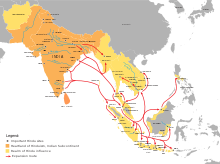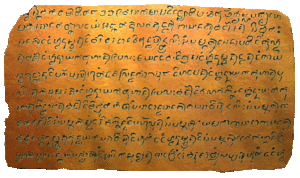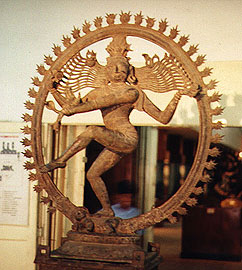Hinduism in the Philippines
 | |
| Total population | |
|---|---|
| 30,634 (2015)[1] | |
| Scriptures | |
| Bhagavad Gita, Mahabharata, Upanishads | |
| Languages | |
| Indo-Aryan languages (Sanskrit, Hindi and Sindhi), Butuanon, Visayan |
| Hinduism by country |
|---|
  |
| Full list |
Recent archaeological and other evidence suggests Hinduism has had some cultural, economic, political and religious influence in the
Hinduism today
This section needs additional citations for verification. (November 2014) |
There is some growth in the religion as of late, although most temples cater to the same communities. Actual adherents of
One source estimated the size of the Indian community in the Philippines in 2008 at 150,000 people, most of whom are Hindus and Christians.
At present, however, it is limited primarily to the immigrant Indian community, though traditional religious beliefs in most parts of the country have strong Hindu and Buddhist influences.
Over the last three decades, a large number of civil servants and highly educated Indians working in large banks, Asian Development Bank and the BPO sector have migrated to Philippines, especially Manila. Most of the Indian Filipinos and Indian expatriates are Hindu, Sikh or Muslims, but have assimilated into Filipino culture and some are Catholic . The community regularly conducts philanthropic activities through bodies such as the Mahaveer foundation, The SEVA foundation and the Sathya Sai organization. Most Hindus congregate for socio-cultural and religious activities at the Hindu Temple (Mahatma Gandhi Street, Paco, Manila), and the Radha Soami Satsang Beas center (Alabang, Muntinlupa, Metro Manila).
History



The archipelagos of Southeast Asia were under the influence of Hindu Tamil Nadu and Indonesian traders through the ports of Malay-Indonesian islands. Indian religions, possibly an amalgamated version of Hindu-Buddhist arrived in Philippines archipelago in the 1st millennium, through the Indonesian kingdom of Srivijaya followed by Majapahit. Archeological evidence suggesting exchange of ancient spiritual ideas from India to the Philippines includes the 1.79 kilogram, 21 carat gold Hindu goddess Agusan (sometimes referred to as Golden Tara), found in Mindanao in 1917 after a storm and flood exposed its location.[5] The statue now sits in the Field Museum of Natural History in Chicago, and is dated from the period 13th to early 14th centuries.
A study of this image was made by Dr. F. D. K. Bosch, of Batavia, in 1920, who came to the conclusion that it was made by local workmen in Mindanao, copying a Ngandjuk image of the early Madjapahit period – except that the local artist overlooked the distinguishing attributes held in the hand. It probably had some connection with the Javanese miners who are known to have been mining gold in the Agusan-Surigao area in the middle or late 14th century. The image is apparently that of a Sivaite goddess, and fits in well with the name "Butuan" (signifying "phallus").
— H. Otley Beyer, 1947[3]
Another gold artifact, from the
In 1989, a laborer working in a sand mine at the mouth of
Folklore, arts and literature
Many fables and stories in Filipino Culture are linked to Indian arts, such as the story of the monkey and the turtle, the race between deer and snail (slow and steady wins the race), and the hawk and the hen. Similarly, the major epics and folk literature of Philippines show common themes, plots, climax and ideas expressed in the Mahabharata and the Ramayana.[12]
According to
Language
With the advent of
Linguistic influence left lasting marks on every
Tagalog

- budhî "conscience" from the Sanskrit bodhi
- Bathalà "bhattara – Hindu God Shiva" from the Sanskrit Bhattara
- dalità "one who suffers" from the Sanskrit dharita
- dukhâ "poverty" from the Sanskrit dukkha
- guró "teacher" from the Sanskrit guru
- sampalatayà "faith" from the Sanskrit sampratyaya
- mukhâ "face" from the Sanskrit mukha
- lahò "eclipse", "disappear" from the Sanskrit rahu
- maharlika "noble" from Sanskrit mahardikka
- saranggola "kite" from Sanskrit layang gula (via Malay)
- bagay "thing" from Tamil "vagai"
- talà "star" from Sanskrit tara
- puto, a traditional rice pastry, from Tamil puttu (via Malay)
- malunggay "moringa" from Tamil "murungai"
- saksí "witness" from Sanskrit saksi
Kapampangan
- kalma "fate" from the Sanskrit karma
- damla "divine law" from the Sanskrit dharma
- mantala -"magic formulas" from the Sanskrit mantra
- upaya "power" from the Sanskrit upaya
- lupa "face" from the Sanskrit rupa
- sabla "every" from the Sanskrit sarva
- lawu "eclipse" from the Sanskrit rahu
- Galura "giant eagle (a surname)" from the Sanskrit garuda
- Laksina "south" (a surname) from the Sanskrit dakshin
- Laksamana/Lacsamana/Laxamana "admiral" (a surname) from the Sanskrit lakshmana
Cebuano
- asuwang "demon" from Sanskrit asura
- balita "news" from Sanskrit varta
- bahandi "wealth" from Sanskrit bhandi
- baya "warning to someone in danger" from Sanskrit bhaya
- budaya "culture" from Sanskrit; combination of boddhi, "virtue" and dhaya, "power"
- diwata "goddess" from Sanskrit devata
- gadya "elephant" from Sanskrit gajha
- puasa "fasting" from Sanskrit upavasa
- saksí "witness" from Sanskrit saksi
Tausūg
- suarga "heaven"; compare sorga in modern Indonesian
- agama"religion"
Ibanag
- karahay a cooking pan similar to the Chinese wok, from the Sanskrit karahi
- tura the word meaning "to write" came from the Sanskrit sutra meaning literature or scripture
- kapo the word cotton from Sanskrit kerpas
Common to many Philippine languages
- sutlá "silk" from the Sanskrit sutra
- kapas "cotton" from the Sanskrit kerpas
- naga "dragon" or "serpent" from the Sanskrit nāga
Hindu temples
This section needs expansion. You can help by adding to it. (July 2021) |
There are Hindu temples in Manila city including Hari Ram Temple (Paco) and Saya Aur Devi Mandir Temple (Paco). There is a Hindu temple called "Indian Hindu Temple" in Cebu City, Philippines. There is a Hindu Temple in Baguio City, Philippines called "Baguio Hindu Temple". In Davao City, it has a Hindu temple and Sikh gurdwara inside a single building called "Davao Indian Temple".
See also
- Butuanon people
- Indian Filipino
- Suyat
- Dambana
References
- ^ "Philippines, Religion And Social Profile". thearda.com. Retrieved January 11, 2021.
- ^ a b Postma, Antoon. (1992), The Laguna Copper-Plate Inscription: Text and Commentary, Philippine Studies, 40(2):183–203
- ^ a b H. Otley Beyer, "Outline Review of Philippine Archaeology by Islands and Provinces," Philippine Journal of Science, Vol.77,Nos.34 (July–August 1947),pp. 205–374
- ^ "Branch Centres - Belur Math - Ramakrishna Math and Ramakrishna Mission".
- ^ a b c Golden Tara Government of the Philippines
- ^ Juan Francisco (1963), A Note on the Golden Image of Agusan, Philippine Studies vol. 11, no. 3 (1963): 390—400
- ISBN 978-9971-69-574-3.
- ISBN 978-9971-69-818-8.
- PMID 33753512.
- ^ a b Anna T. N. Bennett (2009), Gold in early Southeast Asia, ArcheoSciences, Volume 33, pp 99–107
- ^ Dang V.T. and Vu, Q.H., 1977. The excavation at Giong Ca Vo site. Journal of Southeast Asian Archaeology 17: 30–37
- ISBN 978-9712356360, Rex Books, 2nd Edition, pp. 46–47
- ISBN 978-9715425148, pp xxiv – xxv
- ^ Manuel, E. Arsenio (1963), A Survey of Philippine Folk Epics, Asian Folklore Studies, 22, pp 1–76
- ^ "The Indian in the Filipino - INQUIRER.net, Philippine News for Filipinos". Archived from the original on June 21, 2015. Retrieved August 12, 2015.
- ^ Adelaar, K. Alexander (1994). "Malay and Javanese loanwords in Malagasy, Tagalog and Siraya (Formosa)" (PDF). Journal of the Humanities and Social Sciences of Southeast Asia.
Further reading
- El Sanscrito en la lengua Tagalog – T H Pardo de Tavera, Paris, 1887
- The Philippines and India – Dhirendra Nath Roy, Manila 1929 and India and The World – By Buddha Prakash, 1964.
- David Prescott Barrows (1914), A history of the Philippines at Google Books, pages 25–37
External links
- The Laguna Copperplate Inscription by Paul Morrow
- A Philippine Document from 900 A.D. by Hector Santos
- The Tagalog Language From Roots to Destiny by Jessica Klakring
